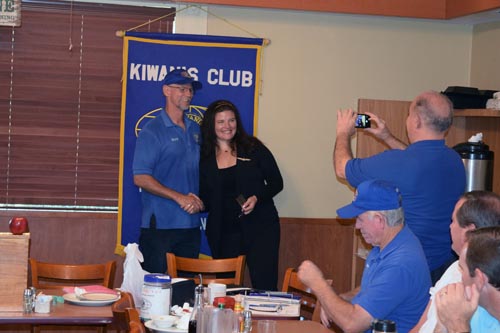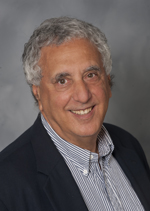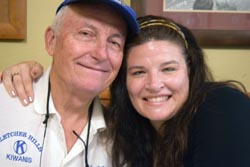
By Donald H. Harrison


EL CAJON, California – A doctoral student in religious anthropology told the Fletcher Hills Kiwanis Club on Saturday morning, Oct. 24, that her spiritual journey, which included conversion to Judaism, began one morning on a high school trip from San Diego County to St. Peter’s Square in Vatican City.
Jenn Lindsay, who writes occasional columns for San Diego Jewish World including one about how she happened to take a “selfie” with Pope Francis, told the Kiwanians that she was a member of the Red-Robed Choir of Grossmont High School that traveled to Italy in 1996.
“There I was, this kid who was interested in religions,” she recalled. “I was particularly enthralled by Judaism and Jewish history but I was sort of an atheist; at least I sort of knew what I thought was right because I was 16 and that is what you are like when you are 16. I was very confident in my intellectual, rational thinking and I remember that morning getting off the big tour bus with the Red-Robed Choir and walking into the piazza of St. Peter’s.
“I saw a line of monks walking with their heads down and I believe they were carrying a rope to stay in line, and they were all adults – adult males – much older than me at the time. I remember I was so struck looking at them. I thought that these are grown-up people who have something to live for that isn’t just their own career, their own ambition, their own stuff; they have something bigger than them. I didn’t have a sense of something bigger than me. And the absence of that sense became a presence in my life, a very motivating presence. It wasn’t really a Catholic moment, but it was certainly a spiritual conversion for me in the piazza of St. Peter’s. … Ever since then, that whole week with the Red-Robed Choir, I was just struck by my mortal humility. I suddenly realized that I didn’t know everything, and that was really hard, and really motivating… That set me on my path to grow up and become a person who talks to people bout their religious beliefs all over the world.”
The Kiwanians listened to the story of her spiritual journey with something akin to family interest. Jenn’s father, Lowell Lindsay, is a member of the Fletcher Hills Kiwanis Club, and Jenn had grown up in the Kiwanis orbit. She had been president of the Grossmont High School Key Club, which is a Kiwanis affiliate, and also had been elected lieutenant governor of the local Key Club district. Over the years, she had appeared before the club in different capacities, so it was only natural that she should give another speech during a three-day visit home before returning to her studies in Rome. Lindsay’s parents, Lowell and Diana, are the owners of Sunbelt Publishing Co., which specializes in the publication and distribution of books about the American Southwest.
Jenn Lindsay was educated at Stanford, Columbia, and Yale, and she is now preparing her dissertation concerning interfaith relations in Rome under the auspices of Boston University. Lindsay has had the opportunity of attending two audiences with the Pope, and has interviewed 70 people thus far about the need for and results of interfaith dialogue.
“Interfaith dialogue is basically when people use religion as a tool to bridge social divides,” she explained. “You bring a Catholic group, a Jewish group and a Muslim group together and then they do whatever they want. There are lots of ways to do interfaith dialogue; the only requirement is that there be more than one faith in the room, and sometimes even secular people who don’t affiliate with any religion. They can have a theological discussion. They can eat food and develop their friendships. They can have a soup kitchen and never even talk about religion.”
She said that interfaith dialogue became possible in Rome only after the Second Vatican Council in 1962 “when the acknowledgment of the inherent worth of other religions was made part of the Catholic Church’s official policy and that was the birth of institutionally sanctioned ways to help religious people reach across religious divides and connect about something bigger than all of them, that they could stand together in awe of.”
Rome has one of the oldest Jewish communities in the world, perhaps the oldest outside Israel.
“Jews have been in Rome since 180 BC(E) when Jews were recorded as being members of the Roman Senate,” she said. The Jewish community was situated then “pretty much where it is now at the Tiber River, about three-quarters of a mile from St. Peter’s Basilica.”
Besides Jews, Protestants were a major non-Catholic group through much of Italy’s history. Protection for both Jews and Protestants was enshrined “in the first constitution of the Northern Kingdom of Italy” and later into the first constitution of the kingdom of Italy in 1870.
Lindsay noted that after the general Giuseppe Garibaldi’s troops took over Rome, the Vatican was all but walled off from the rest of the city, with several Popes virtual prisoners there until 1922 when dictator Benito Mussolini “struck a deal with the Catholic Church that the Vatican could be a sovereign state. This meant that Italy was free to buy real estate that the Vatican had throughout Rome and throughout Italy. What the Vatican really won out of that, other than being an autonomous state, was that it received an agreement from Italy that it could always give catechism instruction in the public schools. That continues to this day.”
That accord remained essentially unchanged until 1985 when a measure was passed “that declared that the state religion of Italy was no longer Catholicism. It was officially a secular state and non-Catholic students in the school were granted the exemption not to receive the catechism in the schools,” Lindsay said. “This was really important for Protestant and Jewish families whose kids had to sit through this for years—inappropriate for non-Catholic families.”
Lindsay said 11 religions have signed protected religion agreements with the Italian State, including the Jews who are represented by a Chief Rabbi. However, Muslims have not signed such an agreement primarily because the Muslims in Italy come from many different parts of the world “and they never have been able to agree on a hierarchical body of leadership that represents them all fairly.” She said some Muslims have “pointed out the irony that the provision for protected religion in Italy asks you to look like the main religion in town. They say ‘why should we have to look like Catholicism in order to be protected as a non-Catholic religion?’ This is all in process still.”
*
Harrison is editor of San Diego Jewish World. He may be contacted via donald.harrison@sdjewishworld.com